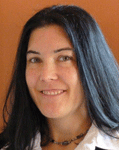Carrie Bruce, MA, CCC-SLP, ATP
 |
Research Scientist, Center for Assistive Technology
|
…on the evolution of assistive devices and technologies
“Looking at the evolution of assistive devices and technologies available for people with MS, one has to realize that ‘state of the art’ is always a moving target. At one point, the folding wheelchair was the latest advancement and people could finally take their chair in the car. Since that time, not only have better wheelchairs come along, but we’ve also seen a broadening of the types of products people with MS need and want – their expectations have grown beyond traditional medical equipment.
“Individuals with MS want to stay active, continue working, engage in educational pursuits, and maintain social connections with as much ease and independence as possible. They also want to rely less on specialized equipment that is expensive and unattractive.
“The past decade has brought a much-needed shift in product design that gives people with MS more choice. The focus on inclusive and universal design means that it is easier to find cars, homes, computers, cell phones, personal care items, and many other things that are both useful and accessible to more people. While these changes are shaping the current ‘state of the art,’ we need to push for product design that keeps up with the ever-changing needs of people with MS.”
Carrie Bruce has worked as a speech-language pathologist in the field of assistive technology and rehabilitation design for almost 20 years. A research scientist at Georgia Tech, she works on grants to develop assistive and universally designed technologies. Her interest in MS began 10 years ago while providing technical assistance to people looking for technologies to help in their daily lives. She connected with MS organizations to learn about their programs and update them on newer technologies and research. Ms. Bruce has written several articles on assistive technology and home modifications and continues to provide input on research and product development that could benefit the community.
